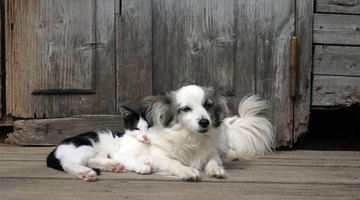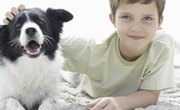Students can study dog behaviors with science projects. Use controlled experiments and quantitative observations to draw conclusions about your pooch's behavior. The best data can be collected by observing a high number of dogs of the same gender, age and breed, except when testing the differences among breeds.
Pick One
Study a dog's sensitivity to several smells. Choose three objects that have an odor that you want to test. These items could be food, an article of clothing from the owner or a favorite toy. In an empty room, put the three objects under identical dog dishes so that they can't be seen. Let the dog into the room and see which dish the dog goes to first. Record your observations. Repeat the experiment with different dogs or with the same dog but change the order or location of the test objects. Be sure that the test object is not poisonous to the dog, such as a piece of chocolate.
Hide And Seek
Test how quickly different dogs can locate an object. Select a test object desirable to a dog, such as a small piece of meat, and hide the object in the room. Let one dog into the room. Use a stop watch to determine how long it takes for the dog to locate the object. Repeat the experiment with a different dog, hiding the test object in the same location. This experiment could be useful to test differences in the abilities of different breeds of dogs if several dogs of a certain breed are available as subjects.

Friend or Foe
This experiment requires a number of animals, both dogs and other species. Determine the reaction that a dog has to a variety of stimuli. Have the dog stand in an empty room. Introduce another animal to the room and record the dog's reaction. Use a scale to make the data more quantitative. For example, if a cat is introduced and the dog barks at first but then grows quiet, it may be rated a "4" for aggressive behavior on a scale of 1-10, 10 being the most aggressive. List certain behaviors for each number on the scale to avoid inconsistent data.

Toy Shopping
Learn about what makes an environment stimulating to a dog by studying what kinds of toys it prefers. Make categories of different types of play toys according to shape, size and texture. Choose one toy from each category and place them in front of the dog. Record which toy the dog approaches first. Remove the first round of objects and replace them with new objects from the same categories. Record your observations and draw conclusions about the nature of the objects the dog prefers.
Related Articles
References
Writer Bio
Pauline Lovingood began writing professionally in 2011. She writes about health, fitness, medicine and travel for various websites. She graduated from Ohio Wesleyan University with a Bachelor of Arts in health and human Sciences.











